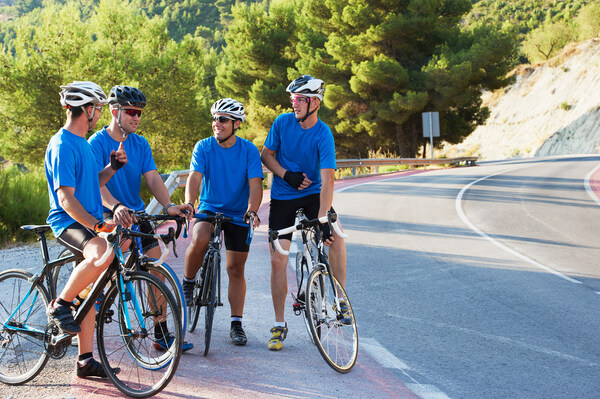General benefits of cycling
Learn the basics of cycling with patience and perseverance. First of all, be prepared for falls – psychologically and physically (put on a helmet, gloves, and protection on your knees), and also tune in to the fact that, perhaps, at first you will succeed with difficulty and not quite ideally, but a couple of classes and you will already be driving your new two-wheeled friend with confidence.

For a cyclist, it is important to burn excess fat not only through physical effort but also as a result of improved energy metabolism, which is also facilitated by cycling.
The body receives a versatile load: both cyclic (leg muscles during pedaling) and static (neck, arms, shoulders). It actively engages all muscle groups.
In addition to the benefits for the figure, the bicycle helps to get rid of a number of diseases of the cardiovascular system.
Who is not suitable for cycling?
For a person who suffers from chronic diseases, any physical activity is indicated only if there is permission from the attending physician. Cycling is no exception. Cycling is contraindicated:
- with chronic heart failure, cardiac arrhythmias, ischemic disease of the third or fourth stage, severe hypertension;
- with any diseases of the spine;
- with severe osteoporosis, some forms of herniated discs;
- in case of a brain tumor;
- suffering from epilepsy;
- with vestibular disorders.
How to organize your driving practice?
First, let’s look at a few points that you should take care of before starting your training. Before buying a bike and related equipment, learn how to ride bikes rented from bikes or borrowed from friends;
For the first time, it is better to choose deserted places. Clothes for classes should be selected in a tight-fitting type, otherwise you risk catching on the rotating elements of the bike. Shoes must not slip on the pedals. It is worth putting on gloves from the first workout to protect your hands from calluses.
If possible, seek help from experienced cyclists among your friends and ask for an introductory briefing, but do not choose those who can tease or who do not have the patience to explain and mess with you. If there are no patient and good skiers, then it is better to study alone.
It is worth starting training from 2-3 times a week for 0.5-1 hours, so as not to overstrain the muscles and have time to mentally tune in to new loads. At first, we advise you to drive on a flat road, but preferably with a slight slope – this will make it easier to learn. When you master the steering, shifting and braking well, you can move on to more difficult tracks – with ups and downs.
How many calories are burned while cycling?
The number of calories burned depends on the weight of the practitioner, speed and time. You should also monitor the pulse so that it is between 120 and 145 beats. On average, you can build on the following results for 1 hour of training:
- With a calm ride (10-15 km / h) – you can burn 200 calories.
- With an average load (20 km / h) – 300 calories.
- With intensive training (30 km / h) – you can burn 400 calories.
- With interval training (alternating 2 minutes – 35 km / h, 3 minutes – 15 km / h) – 600 calories.
Bicycle trainers – benefits and selection criteria
The great advantage of cycling trainers is that you can train all year round and in any weather. An exercise bike can be used by a person who does not know how to ride a bicycle. No need to learn to balance and steer.
The exercise bike belongs to the group of cardio simulators, which, unlike strength ones, have a milder effect on organs and muscles. Regular exercise on a stationary bike helps:
- improve the overall functional state of the body;
- increase vitality, endurance and immunity, prevent chronic diseases, get rid of stress;
- normalize the functioning of the respiratory system, improve blood circulation, strengthen the cardiovascular system, muscles, bones and joints;
- maintain physical fitness, get rid of excess weight and shortness of breath, form a beautiful figure, fat deposits on the hips are burned especially intensively, buttocks and leg muscles are strengthened.
Are cycle lanes popular in the USA?
Cycle lanes in the US are an element of cycling infrastructure that provide a physical separation between cyclists and vehicular traffic. Such lanes are required on high-speed and busy roads, as well as on routes with high intensity of cycling traffic and on recreational cycling routes, often passing separately from roads. Bike lanes attract inexperienced cyclists and boost their confidence, but they also take up a lot of space and are relatively expensive. Bicycle paths provide high traffic safety on hauls, along sections of roads, but can be quite dangerous at intersections.
In small US towns, almost every street is equipped with a bike path. Bicycle parking is available at every school and at every store. And if we are talking about a sports store, then bike racks are not only on the street at the entrance to the store, but also inside it!
Where to find bike lanes in Michigan?
Michigan is a state in the northeastern United States. Michigan is a real paradise for outdoor enthusiasts. There are more than 10 thousand lakes of different sizes, many rivers and waterfalls. Incredibly beautiful landscapes, hundreds of kilometers of scenic trails, bike paths, excellent conditions for surfing, canoeing, fishing at any time of the year – all this attracts tens of thousands of tourists from all over the world to Michigan.
Within the city, cycle paths should be arranged on roads with a speed of 50 km/h or more. On slower streets (from 30 km/h), you should also consider creating bike lanes if the traffic intensity exceeds 4,000 cars per day. Bike lanes are better suited for relatively long stretches of road with few crossings.
